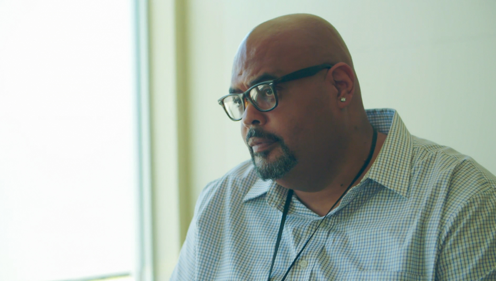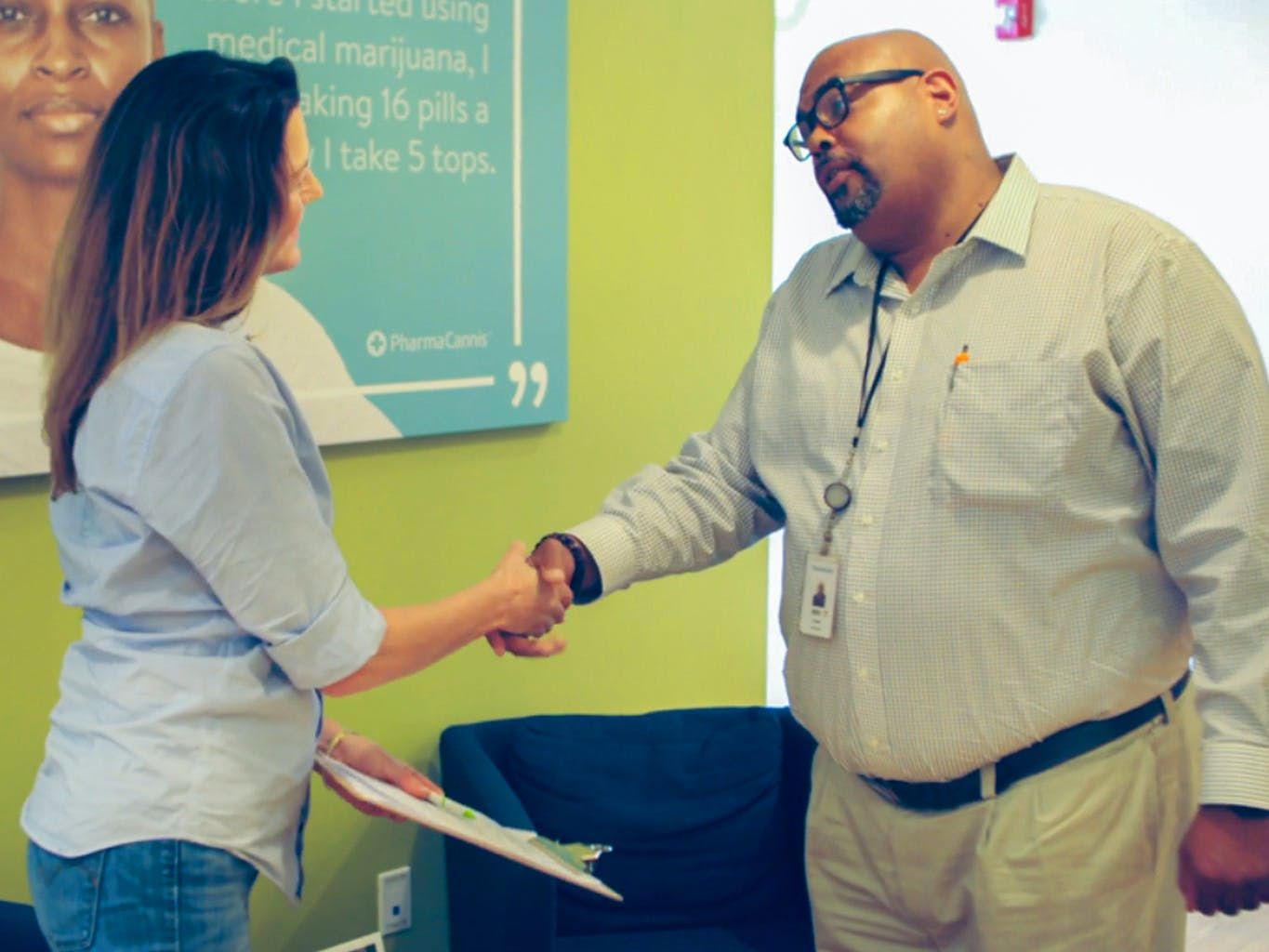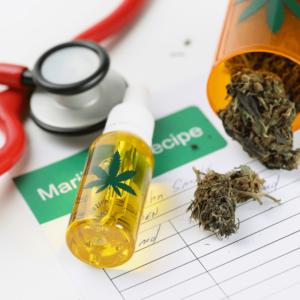Jeff Starr has been aPharmaCannis patient care representative since the company opened its Bronx location in 2016. He’s a self-professed people person who tested his mettle working for a retail pharmacy as a technician and eventually a wellness consultant, making outreach and education an ongoing focus in his work with patients. A proud military veteran with a background working with disabled adults and at-risk youth, Jeff’s deeply personal family history with medical cannabis serves as daily inspiration in his work. We spoke to Jeff to learn more about his experience transitioning from the traditional retail pharmacy environment to medical cannabis.
Q: Tell us a little about yourself and your background.
A: I’ve always enjoyed helping people: That’s what led me to health and human services. I started out working with developmentally disabled adults and high-risk youth before becoming a certified nursing assistant. Eventually I decided it would be great to work for a pharmacy, so I worked for Rite Aid for five years first as a cashier, then as a full-time technician. Then I was promoted to wellness ambassador.
As wellness ambassador, I was responsible for flu shots and different community outreach programs, making sure that we were visible within the community. A lot of people still recognize me from those days.
In the interim, my mother was diagnosed with cancer in 2002, and she developed cachexia, the wasting disease. I asked her doctor what we could do to help with the nausea and appetite loss, and he whispered in my ear, “Get your mom some pot.”

Patient Care Representative Jeff Starr helps educates folks coming to PharmaCannis.
This was before medical cannabis had come to the East Coast. It didn’t take my siblings and me two minutes to think about it. We said, “You know what, let’s give it a shot because that’s our mom.” It gave her a couple of years to be with her grandchildren, and that’s all that matters.
While working for Rite Aid, I met PharmaCannis General Manager and Head Pharmacist Nelson Cuevas. I worked for him for two years as a tech. We stayed in touch after he left, and last year the opportunity with PharmaCannis presented itself.
Q: Were you working in medical cannabis prior to PharmaCannis?
A: No, this is my first time.
Q: What does it mean to be a patient care representative?
A: Individuals come into this therapy from many different perspectives. You have those who have never thought of cannabis as anything; they never thought about using it recreationally or as a medicinal therapy. And then you have people with a lot of experience with cannabis. As a patient care representative, I bridge that gap.
I’m a liaison for individuals learning about cannabis and for individuals who are fully versed. I talk to people about their perspectives, then I get the chance to share what I know with them—to show and educate patients specifically about what cannabis is, which strain and ratio might work for them, because those are determining factors for what our pharmacist would recommend to them.
Q: What are the biggest differences and challenges you’ve experienced between your work in conventional healthcare and your work in cannabis so far?
A: The biggest difference is accessibility. In a pharmacy, anybody can walk up to you at any time, which is a good thing and a bad thing. When I worked at Rite Aid, the opioid epidemic had already started. We saw patients who were normal people when they first got their prescription for a car accident or a simple fall, and those opioids changed so many people in front of our eyes. It was very uncomfortable being there.
With PharmaCannis, patients have done their homework, gone to their doctor, sought out the certification, talked to or gone online to the Department of Health, and then paid their $50. These patients aren’t coming in to waste your time or get something for free, where I’m quite sure if we were open access, it would be a different ball game.
Q: In your opinion, how is PharmaCannis improving the cannabis experience for New Yorkers?
A: Vastly. There are things that the company learned from the Illinois market before we moved into New York. It’s also the atmosphere that Nelson created; he’s very much an educational pharmacist. Taking the time to educate patients about the medicine is especially important because it’s such a new therapy.
We also don’t push patients to buy. I’m not trying to sell you something. I would rather you have the information and be equipped no matter where you go. We really do care about our patients.
Another thing we don’t do is push to try to get them to buy a lot of medicine the first time. During the first visit, we’re really trying to get the patient’s right ratio, but that may take a few tries. So instead of me charging the patient $500 to $600 and telling them to come back next week or month and we’ll try something else, I’ll recommend they try a seven- to 10-day supply of that medicine and see how the body reacts to it. If all goes well, and it’s the right ratio, great. But if not, the patient hasn’t invested hundreds of dollars.
Remember, medical cannabis isn’t covered by insurance; patients pay out of pocket. The Bronx isn’t the most socioeconomically strong borough in New York City. We have people on fixed incomes, people for whom spending $150 is a lot.
Q: As a patient care representative, what do you think it will take to ensure more participation from patients and healthcare providers?
A: The slow start has to do with education. There was no big ad campaign; it was part of New York’s criteria not to allow dispensaries or registered organizations to do heavy advertising. But the word gets out to people. It’s one thing for a person to hear it on CNN or read it in the newspapers, but when the lady next door or your sister- or brother-in-law says they’re trying medical cannabis and it works, the word of mouth is really good as well.
I think the focus should be on more patients. Yes, the physicians are very important, but it’s going to the patients. This is a business of relationships—people have to trust you in order to come to you so that they can feel better.
Q: What’s the most common misconception doctors—and patients—have about cannabis?
A: Because of the “War on Drugs,” we’ve been fed that cannabis is bad, and once it’s bad, it’s always bad. If we look at cannabis historically, before prohibition, it was part of the pharmacology all over the world and was used for many things.
Q: Can you share a success story or anecdote of treating a patient with medical cannabis?
A: I had a patient with multiple sclerosis; her husband rolled her into our office in a wheelchair. He told us specifically that he wasn’t sure that he was happy with this opportunity because they’re Latino. They’d been served the stigma for many years while growing up in New York, and they’ve seen what real drugs like heroin, cocaine and crack do to people. So because this family lumped all drugs together, they thought that cannabis was bad like heroin.
After two months of his wife receiving the treatment, when he comes in and gladly pays her bill, he shakes our hands and says, “Thank you for giving my wife her life back.” That touched my heart. I wasn’t able to articulate that with my mom because it was still a secret—I couldn’t tell anyone that my mom used cannabis to get better, but now I can.
Across the board—with multiple sclerosis, cancer, HIV, chronic pain—all of these patients have said that they’re better off with the medicine we offer them as opposed to the medicine that they’re taking from Big Pharma.
Q: What are you passionate about?
A: At heart, I’m an artist and am passionate about the arts. I love Shakespeare, plays, music, paintings, museums.
I’m most passionate about human beings, my fellow man, the people who have touched my life, and the people whose lives I’ve touched. It’s not about cannabis, it’s about people. At the end of the day, if I can help one person, that’s great.
Q: Finally, where should people go if they want to learn more about accessing cannabis in New York?
A: Come to PharmaCannis, reach out to our dispensary by phone, and we take emails. We’re willing to hold your hand and help you through process. The New York State Department of Health website is also very good. And I’ve heard good things about the care that patients get from the doctors and physicians through HelloMD.
Cannabis works. If the government changes the scheduling and we were able to have colleges and universities study this medicine more in depth, without being worried about being shutdown by the Feds, we would be in a better place as far as helping people.
Have questions about the New York State medical marijuana program? Check out our expert answers on who and what the NY MMJ program covers.
If you’re new to cannabis and want to learn more, take a look at our Cannabis 101 post. HelloMD can help you get your medical marijuana recommendation; it’s 100% online, private and efficient.






